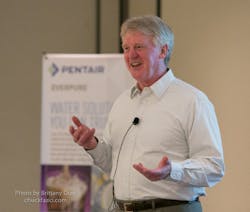There is an ever-familiar experience that I see in coffee service operators that brings together coffee and identity.
It’s a tale of caution, to say the least.
Operator A works in coffee. In fact, Operator A used to live and breathe coffee. Until suddenly a few years went by and coffee sales stayed pretty even. There was no use for Operator A to change the way he sold coffee. He and his employees would order and move boxes marked Coffee, Gourmet Coffee and Specialty Coffee, and Dark Roast Coffee for clients who had run out. Operator A would deliver the boxes and collect the money, which was fine with him because the boxes kept moving and the money kept coming.
Until one day another coffee guy moves in next door. Operator B loves and lives coffee; he specializes in nearly every kind of coffee imaginable. In fact, he even smells like fresh roasted coffee. Operator B loves to talk about the coffee he offers and extols tales about the Yirgecheffe and the Sidamo and the Excelso and the Birundi that he offers from his Melitta pour-over and his espresso lungo and his specially calibrated Grandisimo pronto. And sooner than Operator A can blink, Operator B is showing Operator A’s locations that there is in fact an alternative to ‘coffeeless’ coffee service.
Many operators I speak with at first do not understand this tale of caution. They never think that Operator B would move into their neighborhood. They tell me that Operator B “…is still in San Francisco and Portlandia and downtown somewhere else.”
“Besides,” they say, “none of my customers like that stuff anyway and even if they did their employers would never pay for it.”
My advice to you is that it’s not too late to end the nightmare of a ‘coffeeless’ coffee business.
If you are an operator who buys, sells, distributes or markets coffee—if you are someone who can say that your identity is at least in part ‘coffee’—then you must continually be living coffee. Learn your craft and stay involved in its evolution continuously. Don’t just talk the coffee talk, “walk” coffee for and with your clients.
One way of doing that is through education. Sign up for coffee trend e-newsletters and magazines (there are many out there); network with operators around your region (who aren’t necessarily competitors) on a quarterly basis and discuss different trends you’re both seeing; watch the coffee market stats so you have the knowledge to talk about the volatility of your product. But, first of all, register on-line for 2016 NAMA OneShow in Chicago this April and join us for Coffee Fundamentals, where we will introduce you to coffee sensory training that will awaken the “coffee guru” in you, and prepare you for the new NAMA coffee certificate program being introduced at 2016 NAMA CoffeeTea&Water show.
Don’t wait for Operator B to show up before taking control of your coffee service.
Mike Tompkins is president of Coffee Products Associates and has been the facilitator of the QCCP program since 2000. Named NAMA 2002 OCS Allied Member of the year, Mike Tompkins consults with executives and employees of coffee services, bottled and POU water companies, vending services and retail operations in the US and Canada to execute coffee marketing strategies by owning coffee expertise from bean to cup.





